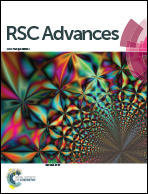Structure modulation on fluorescent probes for biothiols and the reversible imaging of glutathione in living cells†
Abstract
The detection of small molecular biothiols (cysteine, homocysteine and glutathione) is of great importance, as they involve in a series of physiological and pathological processes and are associated with many diseases. To realize the real-time monitoring of a specific biothiol, a rapid and reversible probe is required. Therefore, three probes, namely, o-MNPy, m-MNPy and p-MNPy, with pyridine substituted α, β-unsaturated ketone as the recognition site, were reported here, and the reactivity of the recognition site was finely tuned by the connection mode of the pyridine unit. To single out the optimal one, the response performances of three probes toward each biothiol were systemically studied, taking the differences of the intracellular contents of three biothiols into account during the evaluation. Biothiols reacted with the probes through Michael addition, and results showed that the slight structural variations could affect the performances of the probes obviously. p-MNPy with the pyridine unit connected to the recognition site through the para-position of the nitrogen atom, revealed the best sensing ability among the three probes. It demonstrated rapid response, good selectivity and sensitivity, excellent pH adaptability to Cys and GSH, and displayed reversible detection toward GSH. Finally, p-MNPy was successfully applied to track the GSH fluctuations under the oxidative stress stimulated by H2O2 in living cells.



 Please wait while we load your content...
Please wait while we load your content...